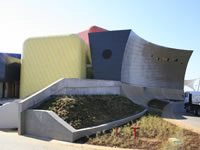 The visually and functionally iconic Soweto Theatre is designed to meet local needs and will be a welcome addition to the cultural landscape of Johannesburg.
The visually and functionally iconic Soweto Theatre is designed to meet local needs and will be a welcome addition to the cultural landscape of Johannesburg.
Since 2006, Jabulani has begun to flourish and claim its rightful place as Soweto’s central business district.
Recently, there have been a number of significant developments in the city, including the R320-million(US$38.8million) Jabulani Mall covering 40,000m2 and the 300 bed Jabulani Provincial Hospital. However, an integral aspect of the city is its arts and culture scene, which will now have a stronghold in the form of the new Soweto Theatre.
The project, which proceeded on time and was completed within the agreed budget of R150-million (US$18million), was handed over to the City of Johannesburg in April 2012. In October 2007 the Johannesburg Property Company issued a request for proposals for development and the tender was awarded to Jabulani Development Company, with a land availability agreement being entered into on 9 December, 2008.
The brief for the Soweto Theatre was to base it on the design concept used at the Northern Stage in Newcastle and the Young Vic in London. These theatres allow for high flexible uses, based on the “universal design” concept.
In addition, the design needed to be “human centred, with core values of social and environmental responsibility”.
The Soweto Theatre comprises three performing venues, the largest of which is a 430-seat venue with a fixed stage and tiered seating. It has a full orchestra pit, a bridge for a fly tower as well as wings.
The other two venues comprise a 180-seater and 90-seater flat floor theatre respectively.
There is a foyer outside the theatre which is a public space that can be used as an additional performance area, a social gathering area during intermission or simply as a pause area. While the project did present a number of challenges, both the targets set for in-service training and the use of local labour were exceeded.
The target to be spent on local labour was R15 million and the actual amount spent to date on local labour is in excess of R20 million.
A number of challenges were faced during the project. These challenges included:
• keeping the project on schedule despite supplier disruptions which included a steel workers’ strike and delays in the delivery of specialised equipment and finishes;
• the design of ducting for cables to outside television broadcast units, while retaining the integrity of fire doors and security concerns;
• making special arrangements to protect the theatre in the event of a fire, when the City’s upgrading plans for the water supply system were behind schedule;
• keeping the community informed of progress and meeting and exceeding empowerment targets;
• selecting local artists for internal finishes and artworks; and
• ensuring an iconic building that will be an inspiration for further development of the new CBD.
The successful addressing of the challenges and the completion of the project on time and within budget is attributable to the highly experienced and competent project team and the excellent working relationship with the client.
Excerpts of original article courtesy of PM Today magazine www.pmtoday.co.uk
